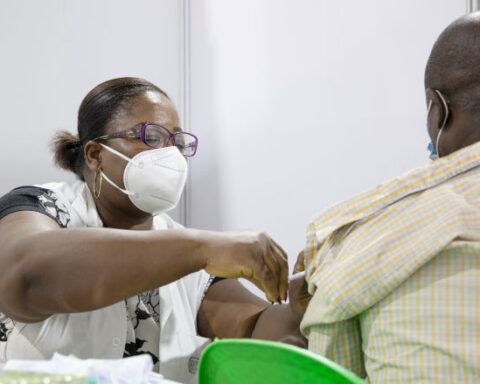ADB’s response to the COVID-19 pandemic utilizing digital technology solutions
The health, economic, and social impacts of the coronavirus disease (COVID-19) pandemic have been deeply felt by everyone in our region. ADB responded quickly with a $20 billion assistance package to support our developing members as they address the crisis and prepare smartly for the new normal.
Let me describe the three pillars of our support and highlight the role digital technology is playing in our response.
Under the first pillar of ADB’s COVID-19 response, we are quickly providing grant support to our developing member countries to address the immediate health impacts by purchasing critical medical equipment and supplies.
We are providing fast-disbursing countercyclical funding under the second pillar to help our member governments implement emergency programs and prepare for recovery. So far, we have committed $8.2 billion in total for 19 countries.
We have also been actively supporting the private sector under our third pillar of support. We provided about $1.7 billion to rejuvenate trade and supply chains and supported enhanced microfinance and guarantees for liquidity-starved businesses, including those run by female entrepreneurs.
Digital technology has played a key role across our COVID-19 response. It enabled effective communication of public health information during the lockdowns, contact-tracing solutions, and quarantine management programs crucial to limiting new COVID-19 infections. Digital technologies have also made remote learning possible while schools remain closed—in many cases, for an indefinite period of time. Our technical assistance program facilitated the implementation of a national ID system in the Philippines that is making social protection programs more effective; and we are incorporating digital health and innovation programs in the Central Asian countries.
We appreciate the support we have received from many of you on our COVID-19 response initiatives. For example, we distributed information and hosted webinars on contact tracing with Google, cloud computing for health with Amazon, and vaccination management with NEC so that our developing member countries can more effectively contain the spread of COVID-19.
Harnessing digital technology for a more inclusive, resilient, and sustainable recovery
Going forward, we will build on our existing efforts in mainstreaming the use of digital technology across sectors, to enable our developing member economies to achieve a more inclusive, resilient, and sustainable recovery. I believe there are four key issues that we need to address regarding the use of digital technology.
First, let us help our developing members seize the opportunities that renewed globalization can offer in a post-pandemic new normal by strengthening regional cooperation and integration. For example, ADB’s support for submarine cables in the Pacific Region, and e-customs systems and electronic cargo tracking system in Central and South Asian countries, will contribute to promoting regional cooperation and integration.
Second, we need to address worsening inequality both in opportunities and income by enhancing access to basic social services, such as health and education. Our national broadband plans in the Philippines and satellite broadband in the Pacific have helped address the digital divide in education. Our support for digital health records in Viet Nam has improved rural access to health services.
A third issue is to facilitate green and resilient recovery by promoting investments that drive economic activity in directions that are low-carbon and resilient. For example, Intelligent Transportation Systems can support real-time traffic control and transport routing systems to manage congestion and reduce air pollution. Smart-Grid systems are helping secure a more efficient energy supply for a green recovery.
Fourth, we need to help the governments strengthen their institutional capacity for mobilizing domestic resources, in order to finance their public services while ensuring debt sustainability. The introduction of Revenue Administration Management Information Systems in many of our developing member economies including Bhutan and the Maldives has led to efficiency improvements in tax filing and processing and an increase in tax yields. ADB also supports an ongoing pilot program in Nepal in collaboration with JAXA (Japan Aerospace Exploration Agency) that uses satellite imagery and Geographic Information Systems (GIS) to help local governments monitor economic activity to better assess property taxes.
We are currently reviewing each sector to identify opportunities that ADB can further support our developing member economies to rebuild smartly with the use of digital technologies. Your suggestions in these areas are highly appreciated.
ADB’s organizational resilience during the COVID-19 pandemic
Let me now touch briefly on how ADB has adapted its working arrangements and business processes during the pandemic.
We moved all of our operations fully online since mid-March and provided options for staff to work from home outside their duty station. As a result, for the first time in ADB’s history, a significant number of staff in our headquarters in Manila and resident offices across the region are working outside of their duty stations. Nonetheless, we delivered highest level of operations, supported by rich knowledge work and strong treasury operations. This underscores the importance of online collaboration tools to enable all of ADB to continue its work across locations and time zones.
Also, for the first time in ADB’s history, we organized our successful 2020 Annual Meeting of the Board of Governors completely virtually this year.
These achievements have been possible due to high morale of staff and significant IT investments we made before the pandemic. However, because the period of work-from-home including outside of duty station is expected to be prolonged, we need to formulate more innovative solutions to address emerging issues. For example, we have to make sure our systems are secure against cyber security attacks. We also have to harness digital technology and data to facilitate our human resources processes.
While we successfully recruited new staff remotely during the strict lockdown period, integrating them into our culture and team under the virtual environment is also a challenge. Keeping our bonds strong and morale high will grow more difficult under this prolonged online work environment. I would appreciate if you could share with us practical solutions for these internal management issues.





